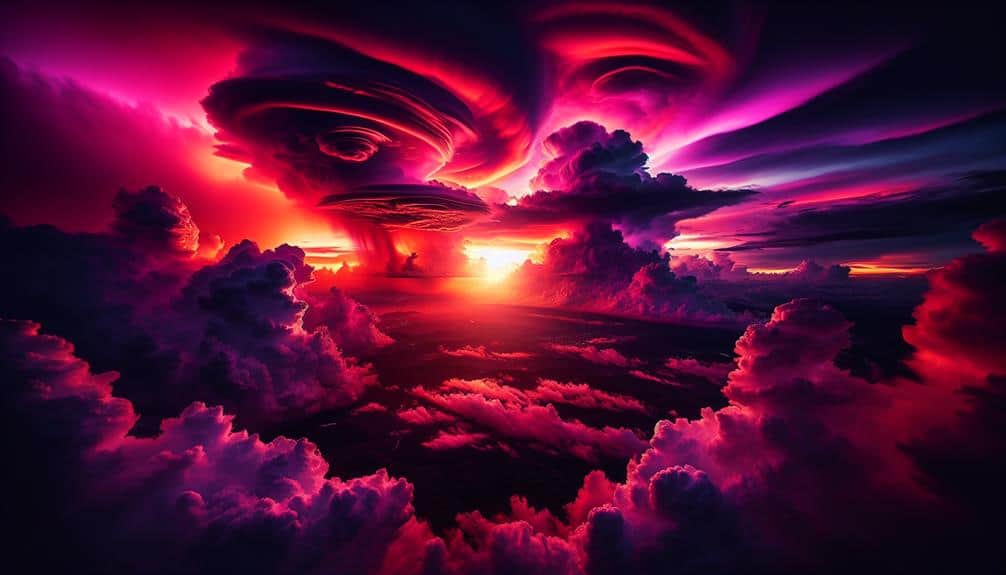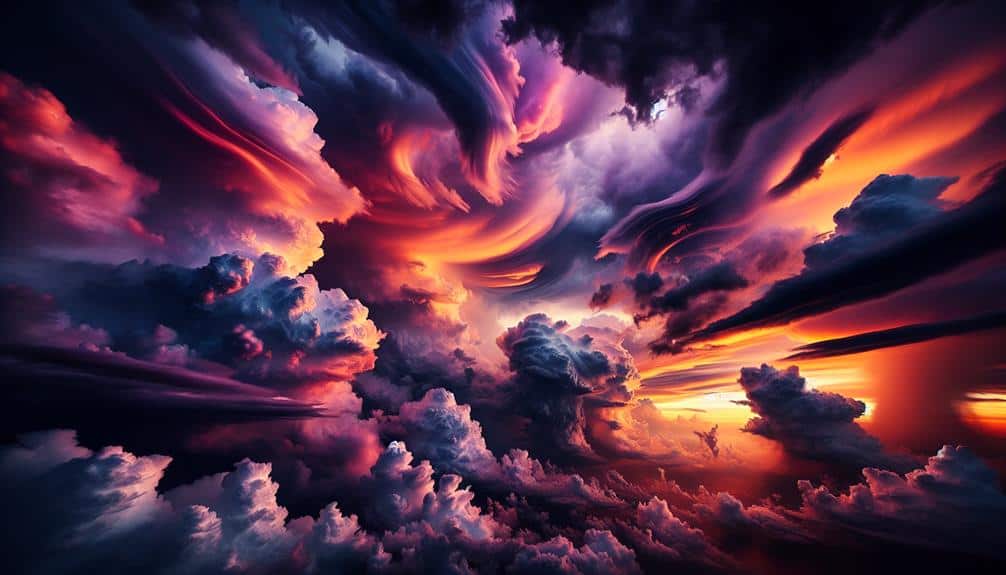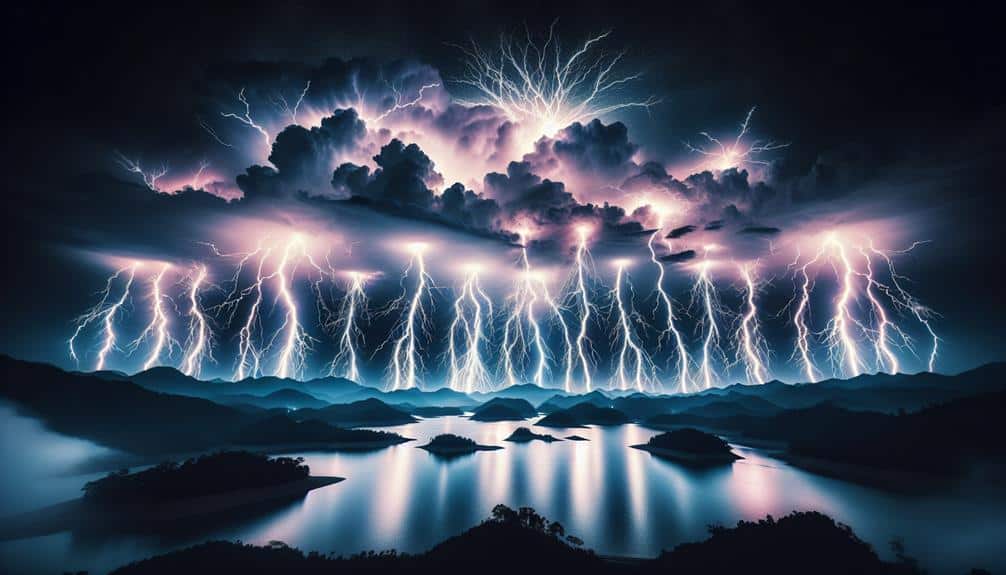We uncover the vibrant hues of sunset storm clouds by combining meteorological science and advanced photography. When atmospheric pressure, temperature, and humidity interact, they form towering cumulonimbus clouds. During the golden hour, sunlight's low angle scatters shorter wavelengths, letting longer ones create crimson and purple shades. High-speed cameras and photodiode sensors freeze lightning, capturing dramatic contrasts. Spectrometers pinpoint these hues, enhancing our understanding of light scattering. By leveraging HDR imaging and time-lapse techniques, we illuminate the evolving patterns and rich textures at sunset. Engage further to explore the intricate synergy between nature's forces and photographic technique.
Key Points
- Crimson and purple hues result from light scattering by atmospheric particulates.
- Golden hour sunlight enhances the palette of storm clouds with vibrant oranges and reds.
- High-speed cameras and photodiodes capture the vivid colors of lightning in stormy skies.
- Meteorological data helps identify optimal conditions for photographing colorful sunset clouds.
The Science of Storm Clouds
Understanding the formation of storm clouds involves examining the complex interactions between atmospheric pressure, temperature, and humidity. These atmospheric conditions are pivotal in cloud formation. When warm, moist air rises, it cools and condenses into water droplets or ice crystals, forming cumulonimbus clouds. These clouds are towering giants, often reaching altitudes of over 12 kilometers, and they're the birthplace of thunderstorms.
In storm science, we use data from weather balloons, satellites, and radars to monitor these conditions. Precise measurements of temperature, humidity, and wind patterns help us predict storm formation and behavior. For instance, a sudden drop in atmospheric pressure is a clear indicator that storm clouds are developing.
Lightning photography captures the raw energy of these storms. By analyzing the frequency and intensity of lightning, we can infer the storm's severity. Each flash of lightning is a result of electrical discharges within the cloud or between the cloud and the ground, driven by the storm's internal dynamics.
In our pursuit of understanding storm clouds, we combine atmospheric data and visual evidence. This approach not only satisfies our curiosity but also enhances our ability to predict and respond to severe weather, offering a greater sense of freedom and preparedness.
Golden Hour Phenomenon
Let's examine the transformative effect of sunlight during the golden hour. During this period, the angle of the sun's rays alters the spectral composition of light, resulting in a remarkable chromatic shift.
We observe the sky's colorful palette evolving from blues to vibrant oranges and reds, enhancing the visual dynamics of storm clouds.
Sunlight's Magical Transformation
During the golden hour, sunlight's interaction with atmospheric particles transforms storm clouds into vivid tapestries of color and light. We observe that the low-angle sunlight traverses a thicker layer of the atmosphere, scattering shorter wavelengths of the light spectrum—such as blues and greens—more intensively. This scattering leaves longer wavelengths, primarily reds and oranges, to dominate the sky.
Weather patterns play a pivotal role in this transformation. As storm clouds form, they consist of various water droplets and ice crystals that further refract and scatter incoming sunlight. The dynamic nature of these clouds, coupled with the varying densities and compositions, creates a complex interplay of light and shadow. Quantitative data indicate that during this period, luminance levels can increase by up to 30%, enhancing the visual impact of these colors.
In essence, we're witnessing a natural phenomenon driven by precise atmospheric conditions and light behavior. The golden hour is a brief window where the elements align perfectly, offering us an awe-inspiring display. It's a tribute to the intricate balance of nature's forces, reminding us of the beauty that can emerge from the interaction of light and weather patterns.
Sky's Colorful Palette
The golden hour's unique atmospheric scattering and refraction transform the sky into a vibrant palette of reds, oranges, and purples, creating a visually stunning phenomenon. During this period, the sun's low angle enhances Rayleigh scattering, allowing shorter wavelengths to disperse while longer wavelengths dominate, producing a vivid spectrum.
This vivid spectrum serves as a wellspring of artistic inspiration, providing a dynamic canvas that artists and photographers keenly capture. Scientifically, this phenomenon results from the sun's light traversing a greater path through the atmosphere, which scatters blue and violet light more extensively, leaving behind an array of warm hues.
Color psychology underscores the emotional impact these colors impart. Reds and oranges evoke feelings of warmth, energy, and passion, while purples can inspire a sense of calm and creativity. These emotional responses aren't merely subjective; they're rooted in our biological responses to color stimuli, influencing our mood and behavior.
As we immerse ourselves in the golden hour, we gain a deeper appreciation for the intricate interplay between light and atmosphere. It's a period that invites us to experience freedom through nature's kaleidoscope, blending scientific wonder with a profound sense of emotional resonance.
Shades of Crimson and Purple

Crimson and purple hues in sunset storm clouds result from the scattering of shorter wavelengths of light by atmospheric particles. When sunlight traverses through the denser lower atmosphere, molecules and small particles scatter shorter wavelengths—violet and blue—more efficiently, leaving longer wavelengths like red and orange to predominate.
Hence, we're met with skies painted in a gradient of crimson and purple, offering a blend that captivates artistic inspiration and underscores nature's beauty.
From a color psychology perspective, these rich hues evoke a spectrum of emotional impact. Crimson often signifies passion and energy, while purple conveys mystery and introspection. Together, they stimulate a powerful and multifaceted emotional response, inspiring feelings of awe and freedom.
Data from various atmospheric studies indicate that higher concentrations of particulates in the atmosphere, either from pollution or natural sources like volcanic eruptions, amplify these colors by enhancing scattering effects.
We can measure the precise wavelengths of these colors using spectrometers, pinpointing the exact shades that dominate during these breathtaking displays. By understanding the scientific principles behind these phenomena, we not only appreciate their beauty but also gain deeper insight into the dynamic interplay between light and atmosphere.
Capturing Lightning in Color
Building on the intricate interplay of light and atmosphere, capturing lightning in color requires high-speed photography and specialized sensors to accurately record the fleeting, vibrant bursts of electricity against the dramatic backdrop of storm clouds. By leveraging advanced techniques, we can achieve stunning imagery that showcases the color contrast of lightning against the stormy skies.
To succeed in lightning photography, we must consider:
- High-Speed Cameras: These are essential for capturing the brief, brilliant flashes. Cameras with high frame rates and quick shutter speeds can freeze the moment lightning strikes, preserving its vibrant hues.
- Specialized Sensors: Employing sensors like photodiodes can detect and trigger the camera at the exact moment lightning occurs, ensuring precise and timely captures.
- Post-Processing Software: Tools like Adobe Lightroom or Photoshop allow us to enhance the color contrast and highlight the dynamic interplay of light and stormy skies.
Cloud Formations and Patterns

Understanding cloud formations and patterns involves analyzing atmospheric conditions and utilizing meteorological data to identify and classify various cloud types. By studying temperature, humidity, wind patterns, and pressure systems, we can determine the characteristics of clouds, such as cumulonimbus, cirrus, and stratus. These parameters help us anticipate the development and movement of storm clouds, essential for both safety and artistic inspiration.
Advanced photography techniques allow us to capture the intricate details of cloud formations, enhancing the visual narrative of storm clouds at sunset. For instance, high dynamic range (HDR) imaging can highlight contrasts between dark storm fronts and the vibrant hues of a setting sun. Time-lapse photography, on the other hand, reveals the evolving patterns of clouds, offering a dynamic perspective that static images can't.
Meteorological data not only aids in predicting weather conditions but also guides us in choosing the best times and angles for capturing dramatic cloud formations. By understanding these patterns, we gain the freedom to explore and document the awe-inspiring beauty of nature.
Our appreciation for these storm clouds isn't just scientific; it's deeply rooted in the artistic inspiration they provide, transforming ordinary skies into celestial masterpieces.
Tips for Perfect Shots
Capturing the perfect shot of sunset storm clouds requires precise timing, a well-chosen vantage point, and an understanding of your camera's capabilities. To harness the full potential of these elements, we need to employ advanced techniques and strategic planning.
First, let's focus on lighting techniques. The interplay of natural light at sunset is essential. We should aim to shoot during the golden hour, when the sun is low and casts a warm glow. This highlights the storm clouds' dramatic textures. Adjusting the camera's exposure settings can further enhance the contrast between the dark clouds and the vibrant hues.
Next, consider framing techniques. Proper framing can transform a good photo into a masterpiece. Incorporate elements like foreground silhouettes or leading lines to guide the viewer's eye through the composition. This adds depth and context to the storm clouds' majesty.
Finally, post-processing remains essential. Here are our top editing tips:
- Enhance contrast to make the colors pop.
- Adjust white balance to maintain the natural warmth of the sunset.
- Use selective sharpening to emphasize cloud details without introducing noise.
Frequently Asked Questions
What Equipment Is Best for Photographing Sunset Storm Clouds?
To photograph sunset storm clouds, we prefer using a DSLR with manual camera settings, a sturdy tripod, lens filters for color enhancement, and a remote shutter to avoid camera shake, ensuring sharp, vibrant images.
How Can Weather Apps Help in Planning a Sunset Storm Cloud Shoot?
Coincidentally, weather apps provide precise forecasts, offering essential photography tips. They help us predict lighting conditions and craft composition techniques. Timely updates on weather forecasts allow us to plan shoots efficiently, ensuring stunning, freedom-inspired captures.
Are There Specific Locations Known for Spectacular Sunset Storm Clouds?
We can find top destinations for sunset storm clouds in places like the Great Plains, Arizona, and the Australian Outback. These locations offer unique experiences due to their seasonal variations and distinct weather patterns, providing stunning visuals.
How Do Pollution Levels Affect the Colors of Sunset Storm Clouds?
We've noticed that pollution impacts color changes in sunset storm clouds. Higher pollution levels can intensify reds and oranges due to particle scattering. However, these atmospheric conditions create photography challenges, requiring precise adjustments to capture accurate hues.
What Post-Processing Techniques Enhance the Colors of Sunset Storm Cloud Photos?
We improve sunset storm cloud photos by boosting color saturation and applying contrast adjustments. Using Lightroom presets for initial tweaks and precise color grading guarantees vibrant, balanced images. These techniques give us creative freedom in post-processing.


